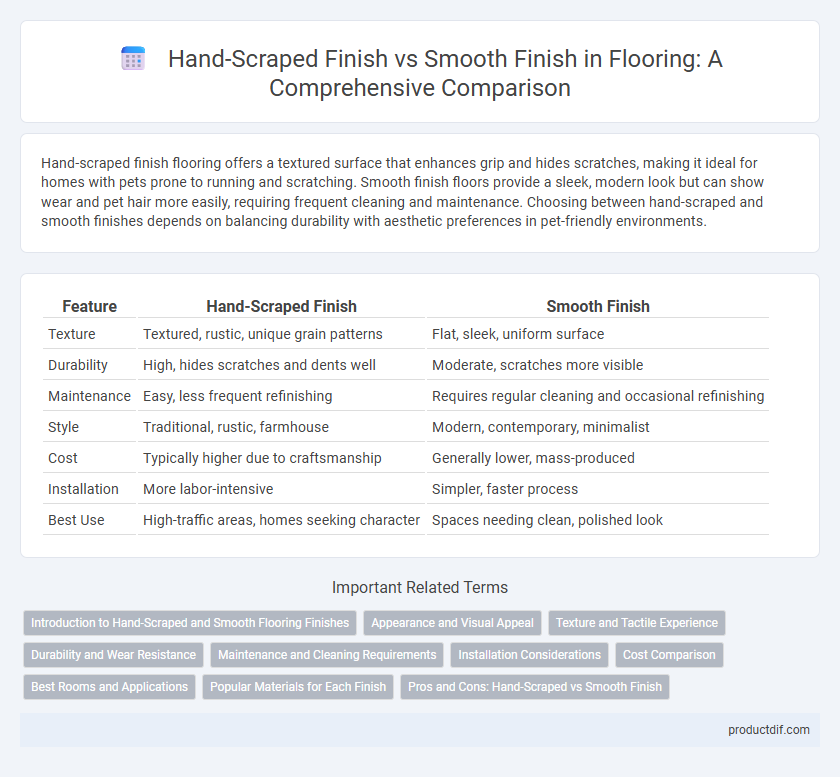Hand-scraped finish flooring offers a textured surface that enhances grip and hides scratches, making it ideal for homes with pets prone to running and scratching. Smooth finish floors provide a sleek, modern look but can show wear and pet hair more easily, requiring frequent cleaning and maintenance. Choosing between hand-scraped and smooth finishes depends on balancing durability with aesthetic preferences in pet-friendly environments.
Table of Comparison
| Feature | Hand-Scraped Finish | Smooth Finish |
|---|---|---|
| Texture | Textured, rustic, unique grain patterns | Flat, sleek, uniform surface |
| Durability | High, hides scratches and dents well | Moderate, scratches more visible |
| Maintenance | Easy, less frequent refinishing | Requires regular cleaning and occasional refinishing |
| Style | Traditional, rustic, farmhouse | Modern, contemporary, minimalist |
| Cost | Typically higher due to craftsmanship | Generally lower, mass-produced |
| Installation | More labor-intensive | Simpler, faster process |
| Best Use | High-traffic areas, homes seeking character | Spaces needing clean, polished look |
Introduction to Hand-Scraped and Smooth Flooring Finishes
Hand-scraped flooring features a textured surface created by distressing wood planks to mimic natural wear, enhancing rustic and vintage appeal. Smooth finishes offer a sleek, polished look with minimal texture, highlighting the wood's grain and color for a contemporary aesthetic. Both finishes use hardwood materials but cater to different design styles and maintenance levels.
Appearance and Visual Appeal
Hand-scraped flooring showcases a textured, rustic appearance with distinctive grooves and a weathered charm that adds character to any room. Smooth finish flooring offers a sleek, polished surface that highlights the natural grain and color of the wood for a modern, clean look. Choosing between hand-scraped and smooth finishes depends on the desired aesthetic, balancing warmth and tradition against contemporary elegance.
Texture and Tactile Experience
Hand-scraped finish flooring offers a textured, rustic surface with natural grooves and undulations that create a warm, tactile experience underfoot, enhancing the visual depth and character of the wood. In contrast, smooth finish flooring provides a sleek, polished surface that feels even and refined, emphasizing a contemporary and clean aesthetic with minimal tactile variation. Selecting between these finishes depends on the desired ambiance and foot sensation, with hand-scraped delivering a more organic, artisanal touch and smooth finish offering a modern, streamlined feel.
Durability and Wear Resistance
Hand-scraped finishes on flooring enhance durability by concealing minor scratches and wear, making them ideal for high-traffic areas. Smooth finishes, while offering a sleek and modern aesthetic, may show scratches and scuffs more easily, requiring more frequent maintenance to preserve their appearance. The textured surface of hand-scraped floors provides superior wear resistance, extending the lifespan of the flooring in busy environments.
Maintenance and Cleaning Requirements
Hand-scraped finish flooring requires more frequent cleaning to remove dirt trapped in its textured grooves, often needing a soft brush or vacuum with a floor attachment to avoid abrasion. Smooth finish flooring offers easier maintenance with simpler sweeping and mopping routines, as its flat surface resists dirt buildup and allows quick spill cleanup. Both finishes benefit from pH-neutral cleaners and avoid harsh chemicals to preserve their surface integrity and appearance.
Installation Considerations
Hand-scraped flooring requires careful alignment of planks to maintain its rustic texture, often necessitating skilled installation to preserve the handcrafted appearance. Smooth finish floors allow for more straightforward installation due to uniform surfaces and minimal variation between boards. Proper subfloor preparation is crucial for both finishes to prevent unevenness that can affect the final look and durability.
Cost Comparison
Hand-scraped flooring typically costs 10% to 20% more than smooth finish options due to the labor-intensive process of creating texture and character. Smooth finish flooring offers a more budget-friendly choice with lower installation and maintenance expenses, appealing to cost-conscious buyers. Price variations also depend on wood species, plank width, and finish quality, impacting the overall investment for homeowners.
Best Rooms and Applications
Hand-scraped finish flooring is ideal for high-traffic areas like living rooms and entryways, as its textured surface effectively hides scratches and dents. Smooth finish flooring suits formal spaces such as dining rooms and bedrooms, providing a sleek, modern look that enhances light reflection. Both finishes offer durability, but hand-scraped excels in rustic or farmhouse styles, while smooth finish complements contemporary and minimalist interiors.
Popular Materials for Each Finish
Hand-scraped finishes are commonly applied to hardwoods like oak, hickory, and maple, enhancing the wood's natural grain and imparting a rustic, textured appearance ideal for traditional and farmhouse styles. Smooth finishes are typically used on materials such as engineered hardwood, bamboo, and laminate, providing a sleek, polished surface that complements modern and contemporary interiors. Both finishes offer durability, but hand-scraped surfaces mask wear over time while smooth finishes highlight the clarity and uniformity of the flooring material.
Pros and Cons: Hand-Scraped vs Smooth Finish
Hand-scraped finish flooring offers a rustic, textured appearance that effectively conceals scratches and wear, making it ideal for high-traffic areas and homes with pets. In contrast, smooth finish flooring provides a sleek, modern aesthetic that is easier to clean but more susceptible to visible dents and scratches over time. While hand-scraped surfaces add character and durability, smooth finishes require more maintenance to preserve their pristine look.
Hand-Scraped Finish vs Smooth Finish Infographic

 productdif.com
productdif.com